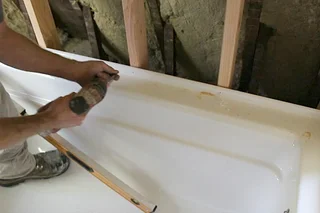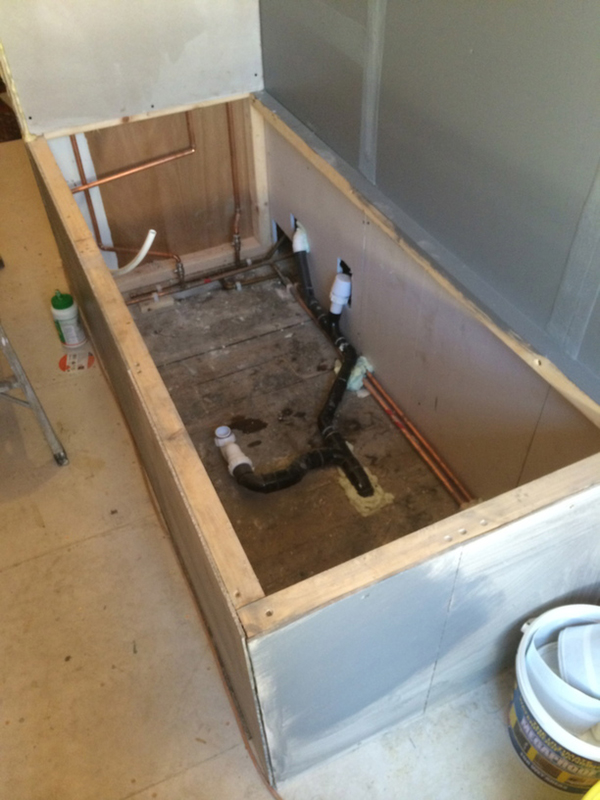Getting Familiar with Plumbing: Your Starting Point for When Installing a Bathtub
Getting Familiar with Plumbing: Your Starting Point for When Installing a Bathtub
Blog Article
How do you really feel when it comes to Installing A Bathtub?

Installing a bathtub isn't exactly brain surgery, yet it does need solid plumbing, carpentry, and occasionally, tiling abilities. Replacing an old bath tub with a brand-new one is likewise a moderately challenging project. If the old tub is readily accessible, the task can relocate speedily; if you need to open up a wall to remove the old bathtub and also position the new bath tub, the task is much harder. In either instance, the job is within a home handyman's abilities, although you will certainly need an assistant to move out the old bathtub and embeded in the new one. Ensure you have certified yourself for the job and also fit attempting it. As opposed to employing a specialist to take over a halfway-completed task, it is much better to take into consideration utilizing one prior to you begin. Possibilities are you may need a professional plumber to make tube links.
This short article will certainly aid you install a new tub in your washroom if you have actually already acquired a brand-new bathtub and don't need to alter the setup of your previous water pipelines.
Your tools and product checklist should make up the following:
Removing Old Touches
If you require to replace old faucets with brand-new ones as a part of your installation, then the first thing you must do is detach the supply of water. After doing so, switch on the taps to drain any water remaining in the system. The procedure of removing the existing taps can be fairly bothersome because of the restricted accessibility that is usually the instance.
Utilize a basin wrench (crowsfoot spanner) or a tap device to reverse the nut that connects the supply pipes to the taps. Have a fabric prepared for the remaining water that will come from the pipes. When the supply pipes have actually been eliminated, make use of the exact same device to loosen the nut that holds the taps onto the bath/basin. You will need to quit the single faucets from turning throughout this procedure. Once the faucets have actually been removed, the holes in the bath/basin will have to be cleaned of any kind of old sealing compound.
Before carrying on to fit the new faucets, compare the pipeline links on the old faucets to the new taps. If the old faucets are longer than the brand-new faucets, then a shank adapter is required for the brand-new faucets to fit.
Fitting New Taps
If the tails of the new faucets are plastic, then you will need a plastic connector to prevent damages to the string. One end of the connector fits on the plastic tail of the faucet and also the other end offers a connection to the current supply pipelines.
If you need to fit a monobloc, then you will need lowering couplers, which connects the 10mm pipe of the monobloc to the typical 15mm supply pipeline.
Next, place the tap in the installing opening in the bath/basin making sure that the washers are in location in between the faucet as well as the sink. Protect the tap in position with the manufacturer given backnut. Once the faucet is securely in place, the supply pipelines can be linked to the tails of the taps. The faucets can either be connected by utilizing corrugated copper piping or with regular faucet adapters. The former kind ought to be connected to the faucet ends first, tightening up just by hand. The supply pipelines can later be linked to the other end. Tighten up both ends with a spanner after both ends have been linked.
Setting up the Bath tub
Utilizing the two wood boards under its feet, place the tub in the required setting. The wooden boards are handy in uniformly spreading out the weight of the bathtub over the location of the boards instead of concentrating all the weight onto 4 small points.
The following objective is to guarantee that the tub is leveled all round. This can be attained by checking the spirit level as well as readjusting the feet on the bathtub until the level reviews degree.
To install taps, fit all-time low of the furthest versatile tap adapter to the appropriate supply pipe by making a compression join; then do the very same for the other faucet.
Switch on the supply of water and inspect all joints and brand-new pipework for leakages and also tighten them if needed. Load the bathtub and likewise examine the overflow electrical outlet and the normal electrical outlet for leakages.
Finally, take care of the bathroom paneling as explained in the producer's user's manual. Tiling and securing around the tub should wait up until the bathtub has actually been used at the very least once as this will certainly settle it right into its final placement.
Getting ready for the Installment
First of all, the sustaining frame supplied with the bathroom should be fitted (if needed) according to the supplier's instructions. Next, fit the faucets or mixer to the bath tub. When suitable the tap block, it is very important to see to it that if the tap includes a plastic washer, it is fitted in between the bathroom as well as the faucets. On a plastic bathroom, it is likewise reasonable to fit a supporting plate under the faucets device to prevent strain on the bath tub.
Fit the adaptable tap adapters to the bottom of both faucets using 2 nuts as well as olives (occasionally supplied with the tub). Fit the plug-hole electrical outlet by smearing mastic filler round the sink electrical outlet hole, and then pass the electrical outlet with the hole in the bathroom. Make use of the nut supplied by the supplier to fit the plug-hole. Take a look at the plug-hole outlet for an inlet on the side for the overflow pipe.
Next, fit the end of the versatile overflow pipeline to the overflow electrical outlet. After that, screw the pipe to the overflow face which need to be fitted inside the bathroom. See to it you make use of every one of the provided washers.
Link the trap to the bottom of the waste outlet on the tub by winding the string of the waste electrical outlet with silicone mastic or PTFE tape, as well as screw on the trap to the outlet. Link all-time low of the overflow tube in a comparable manner.The bath must currently prepare to be fitted in its final setting.
Tiling Around the Bath tub
In the location where the bathroom meets the tile, it is needed to secure the accompanies a silicone rubber caulking. This is essential as the fitting can move enough to break a rigid seal, causing the water to permeate the wall between the bath and also the tiling, bring about issues with wetness and possible leaks to the ceiling below.
You can choose from a selection of coloured sealants to blend in your components and fittings. They are marketed in tubes and also cartridges, and also can securing spaces as much as a size of 3mm (1/8 inch). If you have a bigger void to fill up, you can fill it with spins of drenched newspaper or soft rope. Remember to always fill the bath tub with water prior to sealing, to permit the motion experienced when the bathtub remains in usage. The sealant can fracture rather early if you do not take into account this motion before securing.
Conversely, ceramic coving or quadrant tiles can be made use of to border the bath or shower tray. Plastic strips of coving, which are easy to use and also cut to dimension, are additionally easily available on the market. It is suggested to fit the tiles utilizing water-resistant or water-proof glue and also cement.
Bathtub Installation
How Important Is A Bathtub To Your Home?
High-quality baths, showers, and other bathroom updates are necessary when considering a smart investment in your home. It’s a room that you go to every day and one that is constantly being used by guests.The bathroom is one of the top trafficked rooms in a home and also one of the most valuable in terms of home resale.
Install Piping Before Tub
You will be using your existing drain and waste vent system, but pipes required include the hot and cold water supply lines and a pipe leading to a shower head. A mixing valve and shower head are also needed. Air chambers may be required.
Position the Tub
Lower the tub into place so that the continuous flange fits against the wall studs and rests on 1’x4' or 2’x4' supports. Anchor the tub to the enclosure with nails or screws inserted through the flanges into the studs.
NOTE: Remember, bathtubs and shower stalls may require support framing. A bathtub filled with water is extremely heavy, so check building codes and framing support before installing the tub.
Assemble Drain Connections
Assemble the bathtub drain connections by connecting the tub overflow with the tub drain above the trap, not beyond it. The trap will have a compression fitting that screws over the arm of the overflow assembly.
Place a Pipe For the Shower Head
First, locate a brass female threaded winged fitting and attach it to a framing support via a screw or a nail. Then run a pipe up the wall for the shower head. Sweat or solder the other side of the brass fitting to the top of the pipe.
Attaching Hot and Cold Water Lines
Attach your water lines for both hot and cold by sweating these directly into the hot and cold ports of the mixing valve. The mixing valve will be how water enters the tub’s system, not by the pipes themselves.
Install the Spout
Extend a piece of 1/2 inch pipe, or whichever length is specified in the manufacturer’s instructions, for the tub spout. Sweat on a male threaded fitting at the end of the pipe or use a brass nipple of the proper length and a 1/2 inch cap.
NOTE: At this point you should have your rough-in plumbing work inspected before proceeding further.
Check For Leaks
Restore the water pressure and check the drain connection and the supply pipes for any sign of leaking.
estore the Bathroom Wall
Replace the wall with moisture-resistant drywall as a base for your wall covering. Seal the joints between the wall and your new tub with silicone caulk as protection against water seepage.
https://www.berkeys.com/2016/12/02/bathtub-installation-dallas/

We were made aware of that report on Tools You Need to Install a New Bathtub from an associate on another web address. Don't hesitate to set aside a second to promote this blog if you liked it. Many thanks for going through it.
Certified solutions offered. Report this page